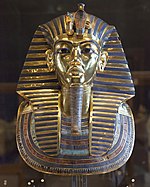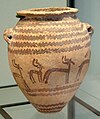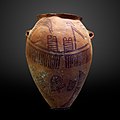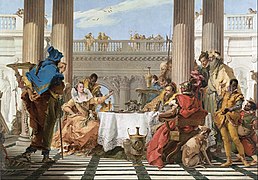Portal:Ancient Egypt
|
THE ANCIENT EGYPT PORTAL
Showcased content about Ancient Egypt Ancient Egypt was a civilization of ancient Northeast Africa. It was concentrated along the lower reaches of the Nile River, situated within the contemporary territory of modern-day Egypt. Ancient Egyptian civilization followed prehistoric Egypt and coalesced around 3100 BC (according to conventional Egyptian chronology) with the political unification of Upper and Lower Egypt under pharaoh or king Menes (often identified with Narmer). The history of ancient Egypt unfolded as a series of stable kingdoms interspersed by periods of relative instability known as "Intermediate Periods". The various kingdoms fall into one of three categories: the Old Kingdom of the Early Bronze Age, the Middle Kingdom of the Middle Bronze Age, or the New Kingdom of the Late Bronze Age. Ancient Egypt reached the pinnacle of its power during the New Kingdom, ruling much of Nubia and a sizable portion of the Levant. After this period, it entered an era of slow decline. During the course of its history, ancient Egypt was invaded or conquered by a number of foreign powers, including the Hyksos, the Nubians, the Assyrians, the Achaemenid Persians, and the Macedonians under Alexander the Great. The Greek Ptolemaic Kingdom, formed in the aftermath of Alexander's death, ruled until 30 BC, when, under Cleopatra, it fell to the Roman Empire and became a Roman province. Egypt remained under Roman control until 642 AD, when it was conquered by the Rashidun Caliphate. The success of ancient Egyptian civilization came partly from its ability to adapt to the conditions of the Nile River valley for agriculture. The predictable flooding and controlled irrigation of the fertile valley produced surplus crops, which supported a more dense population, and social development and culture. With resources to spare, the administration sponsored mineral exploitation of the valley and surrounding desert regions, the early development of an independent writing system, the organization of collective construction and agricultural projects, trade with surrounding regions, and a military intended to assert Egyptian dominance. Motivating and organizing these activities was a bureaucracy of elite scribes, religious leaders, and administrators under the control of a pharaoh, who ensured the cooperation and unity of the Egyptian people in the context of an elaborate system of religious beliefs.[1] The many achievements of the ancient Egyptians include the quarrying, surveying, and construction techniques that supported the building of monumental pyramids, temples, and obelisks; a system of mathematics, a practical and effective system of medicine, irrigation systems, and agricultural production techniques, the first known planked boats, Egyptian faience and glass technology, new forms of literature, and the earliest known peace treaty, made with the Hittites. Ancient Egypt has left a lasting legacy. Its art and architecture were widely copied, and its antiquities were carried off to be studied, admired or coveted in the far corners of the world. Its monumental ruins have inspired the imaginations of travelers and writers for millennia. A newfound respect for antiquities and excavations in the early modern period by Europeans and Egyptians has led to the scientific investigation of Egyptian civilization and a greater appreciation of its cultural legacy. (Full article...) Selected article - Cleopatra VII, the last ruler of Ptolemaic Egypt, died on either 10 or 12 August, 30 BC, in Alexandria, when she was 39 years old. According to popular belief, Cleopatra killed herself by allowing an asp (Egyptian cobra) to bite her, but according to the Roman-era writers Strabo, Plutarch, and Cassius Dio, Cleopatra poisoned herself using either a toxic ointment or by introducing the poison with a sharp implement such as a hairpin. Modern scholars debate the validity of ancient reports involving snakebites as the cause of death and whether she was murdered. Some academics hypothesize that her Roman political rival Octavian forced her to kill herself in a manner of her choosing. The location of Cleopatra's tomb is unknown. It was recorded that Octavian allowed for her and her husband, the Roman politician and general Mark Antony, who stabbed himself with a sword, to be buried together properly. Cleopatra's death effectively ended the final war of the Roman Republic between the remaining triumvirs Octavian and Antony, in which Cleopatra aligned herself with Antony, father to three of her children. Antony and Cleopatra fled to Egypt following their loss at the 31 BC Battle of Actium in Roman Greece, after which Octavian invaded Egypt and defeated their forces. Committing suicide allowed her to avoid the humiliation of being paraded as a prisoner in a Roman triumph celebrating the military victories of Octavian, who would become Rome's first emperor in 27 BC and be known as Augustus. Octavian had Cleopatra's son Caesarion (also known as Ptolemy XV), rival heir of Julius Caesar, killed in Egypt but spared her children with Antony and brought them to Rome. Cleopatra's death marked the end of the Hellenistic period and Ptolemaic rule of Egypt, as well as the beginning of Roman Egypt, which became a province of the Roman Empire. (Full article...) Selected picture
The Rosetta Stone is a fragment of a granite stele containing a decree written in Hieroglyphs, Demotic, and Greek. Discovered in 1799, the stone contributed greatly to the process of hieroglyph decipherment. Did you know...
News5th September 2018. Rock-cut Tomb discovered in a 4,000-year-old Elite Cemetery August 2018: in the tomb of the mayor of Memphis Ptahmose who dates around 1300 BC was found well preserved cheese, more than 3000 years old. [1] Selected biography -Ramesses VI Nebmaatre-Meryamun (sometimes written Ramses or Rameses, also known under his princely name of Amenherkhepshef C) was the fifth ruler of the Twentieth Dynasty of Egypt. He reigned for about eight years in the mid-to-late 12th century BC and was a son of Ramesses III and queen Iset Ta-Hemdjert. As a prince, he was known as Ramesses Amunherkhepeshef and held the titles of royal scribe and cavalry general. He was succeeded by his son, Ramesses VII Itamun, whom he had fathered with queen Nubkhesbed. After the death of the ruling pharaoh, Ramesses V, who was the son of Ramesses VI's older brother, Ramesses IV, Ramesses VI ascended the throne. In the first two years after his coronation, Ramesses VI stopped frequent raids by Libyan or Egyptian marauders in Upper Egypt and buried his predecessor in what is now an unknown tomb of the Theban necropolis. Ramesses VI usurped KV9, a tomb in the Valley of the Kings planned by and for Ramesses V, and had it enlarged and redecorated for himself. The craftsmen's huts near the entrance of KV9 covered up the entrance to Tutankhamun's tomb, saving it from a wave of tomb robberies that occurred within 20 years of Ramesses VI's death. Ramesses VI may have planned and made six more tombs in the Valley of the Queens, none which are known today. (Full article...) General imagesThe following are images from various ancient Egypt-related articles on Wikipedia.
Related portalsWikiProjectsMain topics
Notable Pharaohs
CategoriesRecognized content
Featured articles
Featured listsGood articles
Did you know? articles
Featured pictures
In the News articlesMain page featured articles
Main page featured listsPicture of the day pictures
Things to do
WikimediaThe following Wikimedia Foundation sister projects provide more on this subject:
Sources
Discover Wikipedia using portals |







































































